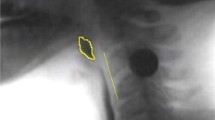Abstract
Temporal measures of normal pediatric oropharyngeal deglutition have not been studied. Knowledge of range and variation of normative temporal measures could define abnormal deglutition and assist in design of appropriate compensatory and rehabilitative treatment techniques. The purpose of this retrospective study was to determine temporal measurements for oral filling, oral transit, onset of laryngeal closure, time of bolus arrival at the valleculae, pharyngeal delay, pharyngeal transit, and UES opening. Videofluoroscopic swallow studies of 15 normally swallowing pediatric subjects were divided into three age groups and method of liquid delivery. Mean, standard deviation, percentages, and extension of the median were utilized to determine relationships of temporal measures. Mean temporal duration increased with age for oral filling, oral transit time, time of laryngeal closure, UES opening, and pharyngeal delay time. However, no significant differences were found between age groups indicating a deglutitive biomechanical adaptation to growth of the oral and pharyngeal cavity. Feeding method for bottle versus cup mean duration increased for oral transit time, laryngeal closure time, UES opening, and pharyngeal delay time. Bolus head location relative to onset of laryngeal vestibule closure changed with increased age and method of feeding. Temporal measures were not significantly different for age groups or feeding methods. Bolus location was at or fully contained in the valleculae at the onset of laryngeal closure and appeared to be a normal finding in functional pediatric swallows and is not indicative of a delay or disorder.














Similar content being viewed by others
References
Arvedson J, Brodsky L. Pediatric swallowing and feeding: assessment and management. 2nd ed. Albany, NY: Singular Publishing Group; 2002.
Logemann J. Evaluation and treatment of swallowing disorders, 2nd ed. Austin, TX: Pro-Ed; 1998.
Kim Y, McCullough G, Asp C. Temporal measurements of pharyngeal swallowing in normal populations. Dysphagia. 2005;20(4):290–6.
Leonard R, McKenzie S. Hyoid-bolus transit latencies in normal swallow. Dysphagia. 2006;21(3):183–90.
Logemann J, Pauloski B, Rademaker A, Kahrilas P. Oropharyngeal swallow in younger and older women: videofluoroscopic analysis. J Speech Lang Hear Res. 2002;45:434–45.
Martin-Harris B, Brodsky M, Price C, Michel Y, Walters B. Temporal coordination of pharyngeal and laryngeal dynamics with breathing during swallowing: single liquid swallows. J Appl Physiol. 2003;94:1735–43.
Kleinjan K, Logemann J. Effects of repeated wet and dry swallows in healthy adult females. Dysphagia. 2002;17(1):50–6.
Mendell D, Logemann J. A retrospective analysis of the pharyngeal swallow in patients with a clinical diagnosis of GERD compared with normal controls: a pilot study. Dysphagia. 2002;17(3):220–6.
Robbins J, Hamilton J, Lof G, Kempster G. Oropharyngeal swallowing in normal adults of different ages. Gastroenterology. 1992;103:823–9.
Bronwen K, Huckabee M, Jones R, Frampton C. The first year of human life: coordinating respiration and nutritive swallowing. Dysphagia. 2007;22:37–43.
Ruark J, McCullough G, Peters R, Moore C. Bolus consistency and swallowing in children and adults. Dysphagia. 2002;17(1):24–33.
Morris S, Klein M. Pre-feeding skills. 2nd ed. Tucson, AZ: Therapy Skill Builders; 2000.
Bosma J. Development of feeding. Clin Nutr. 1986;5:210–8.
Siegel S. Nonparametric statistics for the behavioral sciences. New York: McGraw-Hill; 1956.
Collins C, Ryan P, Crowther C, McPhee A, Paterson S, Hiller J. Effect of bottles, cups, and dummies on breast feeding in preterm infants: a randomised controlled trial. BMJ. 2004;329:193–8.
Marinelli K, Burke G, Dodd V. A comparison of the safety of cup feedings and bottlefeedings in premature infants whose mothers intend to breastfeed. J Perinatol. 2001;21:350–5.
Howard C, de Blieck E, ten Hoopen C, Howard F, Lanphear B, Lawrence R. Physiologic stability of newborns during cup- and bottle-feeding. Pediatrics. 1999;104:1204–7.
Hiss S, Strauss M, Treole K, Stuart A, Boutilier S. Effects of age, gender, bolus volume, bolus viscosity, and gestation on swallowing apnea onset relative to lingual bolus propulsion onset in normal adults. J Speech Lang Hear Res. 2004;47:572–83.
Shahrbanoo F, Punwani I, Jain L, Vidyasagar D. Mechanics and energetics of nutritive sucking: a functional comparison of commercially available nipples. J Pediatr. 1997;130(5):740–5.
Daniels S, Corey D, Hadskey L, Legendre C, Priestly D, Rosenbek JC, Foundas AL. Mechanism of sequential swallowing during straw drinking in healthy young and older adults. J Speech Lang Hear Res. 2004;47:33–45.
Newman L, Cleveland R, Blickman J, Hillman R. Videofluoroscopic analyses of the infant swallow. Invest Radiol. 1991;26:870–3.
Burke P. Swallowing and the organization of sucking in the human newborn. Child Dev. 1997;48:523–31.
Rommel N, Bellon E, Hermans R, Smet M, De Meyer A, Feenstra L, Dejaeger E, Veereman-Wauters G. Development of the orohypopharyngeal cavity in normal infants and young children. Cleft Palate Craniofac J. 2003;40(6):606–11.
Author information
Authors and Affiliations
Corresponding author
Rights and permissions
About this article
Cite this article
Weckmueller, J., Easterling, C. & Arvedson, J. Preliminary Temporal Measurement Analysis of Normal Oropharyngeal Swallowing in Infants and Young Children. Dysphagia 26, 135–143 (2011). https://doi.org/10.1007/s00455-010-9283-3
Received:
Accepted:
Published:
Issue Date:
DOI: https://doi.org/10.1007/s00455-010-9283-3




